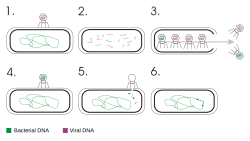Transduction (genetics) - Simple English Wikipedia, the free encyclopedia

Transduction how a virus moves DNA from one bacterium to another.[1]
Joshua Lederberg and his graduate student Norton Zinder showed in 1952 that bacteriophages could transfer genetic information between bacteria in Salmonella.[2] This explained how bacteria of different species could gain resistance to the same antibiotic very quickly.
Transduction also refers to the process whereby foreign DNA is introduced into another cell via a viral vector. This is a common tool used by molecular biologists to introduce a foreign gene into a host cell's genome.
When bacteriophages infect a bacterial cell, they usually reproduce by using the replicational, transcriptional, and translation machinery of the host bacterial cell to make many complete viral particles, including the viral DNA or RNA and the protein coat. Errors in this process can result in the virus carrying over DNA from one bacterium to another.
References
[change | change source]- ↑ Jones, Elizabeth; Hartl, Daniel L. (1998). Genetics: principles and analysis. Boston: Jones and Bartlett Publishers. ISBN 0-7637-0489-X.
{{cite book}}: CS1 maint: multiple names: authors list (link) - ↑ Zinder, Norton D. & Joshua Lederberg 1952. Genetic exchange in Salmonella. Journal of Bacteriology 64(5), 679-699


 French
French Deutsch
Deutsch